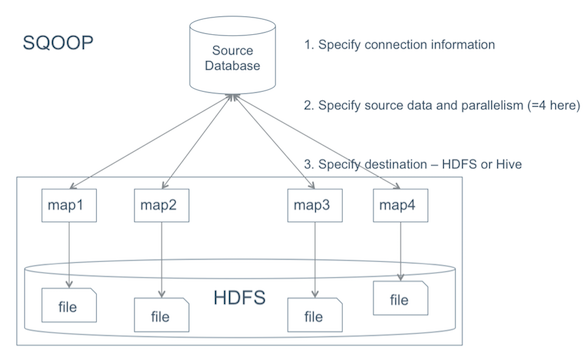Using Sqoop to Move Data into Hive
Sqoop is a tool that enables you to bulk import and export data from a database. You can use Sqoop to import data into HDFS or directly into Hive. However, Sqoop can only import data into Hive as a text file or as a SequenceFile. To use the ORC file format, you must use a two-phase approach: first use Sqoop to move the data into HDFS, and then use Hive to convert the data into the ORC file format as described in the above Steps 3 and 4 of "Moving Data from HDFS to Hive Using an External Table."
A detailed Sqoop user guide is available on the Apache web site here.
The process for using Sqoop to move data into Hive is shown in the following diagram:
Moving Data into Hive Using Sqoop
Specify the source connection information.
First, you must specify the:
database URI (
db.foo.comin the following example)database name (
bar)connection protocol (
jdbc:mysql:)
For this example, use the following command:
sqoop import --connect jdbc:mysql://db.foo.com/bar --table EMPLOYEES
If the source database requires credentials, such as a username and password, you can enter the password on the command line or specify a file where the password is stored.
For example:
Enter the password on the command line:
sqoop import --connect jdbc:mysql://db.foo.com/bar --table EMPLOYEES --username <username> -P Enter password: (hidden)
Specify a file where the password is stored:
sqoop import --connect jdbc:mysql://db.foo.com/bar --table EMPLOYEES --username <username> --password-file ${user.home}/.password
More connection options are described in the Sqoop User Guide on the Apache web site.
Specify the data and the parallelism for import:
Specify the data simply.
Sqoop provides flexibility to specify exactly the data you want to import from the source system:
Import an entire table:
sqoop import --connect jdbc:mysql://db.foo.com/bar --table EMPLOYEES
Import a subset of the columns from a table:
sqoop import --connect jdbc:mysql://db.foo.com/bar --table EMPLOYEES --columns "employee_id,first_name,last_name,job_title"
Import only the latest records by specifying them with a WHERE clause and then that they be appended to an existing table:
sqoop import --connect jdbc:mysql://db.foo.com/bar --table EMPLOYEES --where "start_date > '2010-01-01'" sqoop import --connect jdbc:mysql://db.foo.com/bar --table EMPLOYEES --where "id > 100000" --target-dir /incremental_dataset --append
You can also use a free-form SQL statement.
Specify parallelism.
There are three options for specifying write parallelism (number of map tasks):
Explicitly set the number of mappers using
--num-mappers. Sqoop evenly splits the primary key range of the source table:sqoop import --connect jdbc:mysql://db.foo.com/bar --table EMPLOYEES --num-mappers 8
In this scenario, the source table must have a primary key.
Provide an alternate split key using
--split-by. This evenly splits the data using the alternate split key instead of a primary key:sqoop import --connect jdbc:mysql://db.foo.com/bar --table EMPLOYEES --split-by dept_id
This method is useful if primary keys are not evenly distributed.
When there is not split key or primary key, the data import must be sequential. Specify a single mapper by using
--num-mappers 1or--autoreset-to-one-mapper.
Specify the data using a query.
Instead of specifying a particular table or columns, you can specify the date with a query. You can use one of the following options:
Explicitly specify a split-by column using
--split-byand put$ CONDITIONSthat Sqoop replaces with range conditions based on the split-by key. This method requires a target directory:sqoop import --query 'SELECT a.*, b.* FROM a JOIN b on (a.id == b.id) WHERE $CONDITIONS' --split-by a.id --target-dir /user/foo/joinresults
Use sequential import if you cannot specify a split-by column:
sqoop import --query 'SELECT a.*, b.* FROM a JOIN b on (a.id == b.id) WHERE $CONDITIONS' -m 1 --target-dir /user/foo/joinresults
To try a sample query without importing data, use the
evaloption to print the results to the command prompt:sqoop eval --connect jdbc:mysql://db.foo.com/bar --query "SELECT * FROM employees LIMIT 10"
Specify the destination for the data: HDFS or Hive.
Here is an example of specifying the HDFS target directory:
sqoop import --query 'SELECT a.*, b.* FROM a JOIN b on (a.id == b.id) WHERE $CONDITIONS' --split-by a.id --target-dir /user/foo/joinresults
If you can add text data into your Hive table, you can specify that the data be directly added to Hive. Using
--hive-importis the primary method to add text data directly to Hive:sqoop import --connect jdbc:mysql://db.foo.com/corp --table EMPLOYEES --hive-import
This method creates a metastore schema after storing the text data in HDFS.
If you have already moved data into HDFS and want to add a schema, use the
create-hive-tableSqoop command:sqoop create-hive-table (generic-args) (create-hive-table-args)
Additional options for importing data into Hive with Sqoop:
Table 1.6. Sqoop Command Options for Importing Data into Hive
Sqoop Command Option
Description
--hive-home <directory>Overrides
$HIVE_HOME.--hive-importImports tables into Hive using Hive's default delimiters if none are explicitly set.
--hive-overwriteOverwrites existing data in the Hive table.
--create-hive-tableCreates a hive table during the operation. If this option is set and the Hive table already exists, the job will fail. Set to
falseby default.--hive-table <table_name>Specifies the table name to use when importing data into Hive.
--hive-drop-import-delimsDrops the delimiters
\n,\r, and\01from string fields when importing data into Hive.--hive-delims-replacementReplaces the delimiters
\n,\r, and\01from strings fields with a user-defined string when importing data into Hive.--hive-partition-keySpecifies the name of the Hive field on which a sharded database is partitioned.
--hive-partition-value <value>A string value that specifies the partition key for data imported into Hive.
--map-column-hive <map>Overrides the default mapping from SQL type to Hive type for configured columns.


